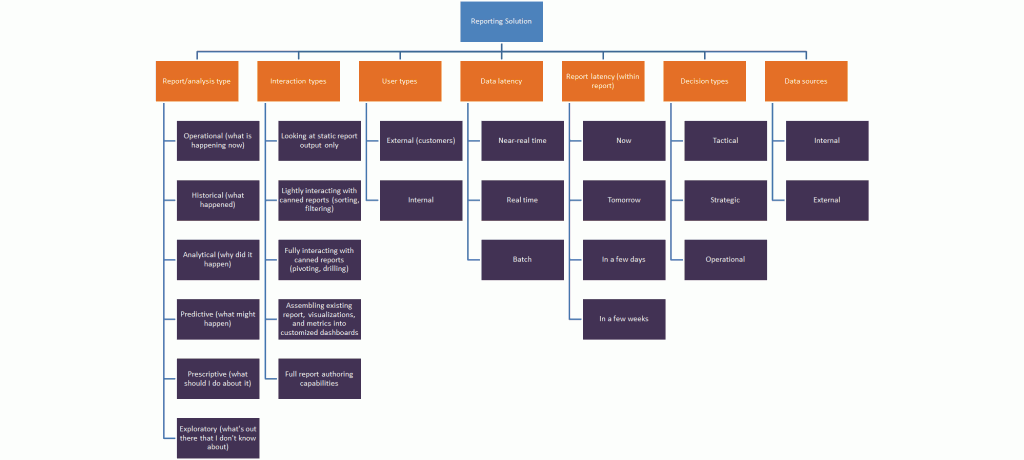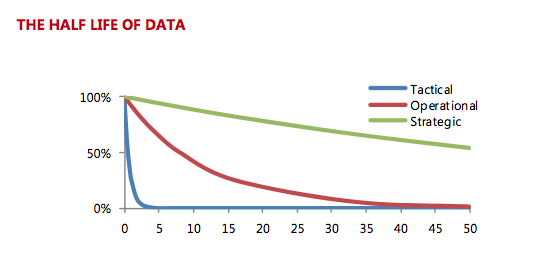What is Business Intelligence (BI)

Ok, this might be abit of a general question, as am sure anyone who found themselves in this blog knows a thing or two about BI, but in this post I will try to give a more holistic overview of what is a full Business Intelligence offering, and what dimensions constitutes a full analytical offering. Additionally, having a BI infrastructure is all well and good, but at the end of the day, the over-all goal of any BI platform is to identify and act upon the data as quickly as possible, when the data is most useful for strategic, tactical or operational business decisions, a concept that we will try and explore in this article.
There are many sides to a full BI platform, and each solution out-there covers a different proportion of the full Business Intelligence picture, but as far as I can see, none can actually satisfy and tick all boxes, even market leaders such as Oracle, IBM or Microsoft still lack some BI “dimensions” or areas that a BI solution covers. When picking a Business Intelligence platform, don’t try to go broad and cover as many boxes as possible, although this might be good if you are planning on stabbing in the dark to see what works and what doesn’t within your organization, and it might be good for organizations who haven’t yet made up their mind on what BI means to them and how they can employ it successfully for making better business decisions, but if you know what you want, and if you have a good handle on your business data requirements, then it is recommended to choose a solution that does what you want really well, better than choosing a solution that does everything but requires a large amount of configuration and development.
It is also important to remember that although the market leaders are good at the broader aspect BI, and possibly better at empowering developers, power-users and end-users to do their own analysis, it is sometimes much easier to just opt in for a specialized BI tool for your specific vertical, for example there are many specialized platforms that are geared up towards financial data business intelligence, these contain many out-of-the-box tools and options that are fine tuned towards your vertical, and might offer a much stronger advantage in terms of getting something up and running quickly. The problem that you might experience with such solutions though is their extensibility, so be careful and know as much as you can what you want from your Business Intelligence solution.
The Dimensions of Business Intelligence
Now the question is: what do you want a business intelligence framework/solution/platform to do for you?, well I’ve created this handy graph below that essentially walks you through the different dimensions you will encounter within a full BI offering, as I mentioned, no single solution or technology covers every aspect in a comprehensive manner, but many come close.
What I like to do is colour-code which of these dimensions we currently cover well using our existing BI technology, which ones we could be covering better (i.e. we do it, but we don’t do it so well), and finally a colour for anything we don’t currently do. This helps decision makers in your organization (such as your CTO) see the big picture, as well as feedback on what direction they would like to take the current BI platform.
One area which not many organizations do well is their approach to “Near-real time” and “Real time” attributes within the Data Latency business intelligence dimension, many organizations seem to be lagging behind in that area, which is extremely crucial in terms of data-value, not having the right data at the right time is like going to a party after everyone went home… its not fun.
The Data Half-life of Usefulness
Basically data has what they call a “Half-Life of Usefulness” in relation to the decision type this data is helping to facilitate (whether this is Tactical decision, Operational or Strategic), the higher the data-latency is, the weaker (or less useful) that data becomes in relation to making a useful decision, in fact, this relationship has been graphed and it looks something like this:
It can be seen from the graph above that “Tactical Decisions” drop to pretty much zero after a very short time, without a low data-latency system we are unable to be effectively reactive on a tactical level, which as far as most organization is concerned, this is the space were a company can innovate using BI and outdo their competitors, and be as reactive to the market they are in as possible.
Also, being reactive is great, and the quicker (and more accurate) an organization reacts to change, the stronger that organization will be in their vertical or market, and the more likely they will be seen as a market leader rather than a follower. But these days becoming reactive is not the end of the line, and with more clever data-mining algorithms getting packages with Business Intelligence solutions, and out-of-the-box deployments include ready-to-use algorithms, becoming “pre-active” is really were you want to be at in order to become the leader in your market.







Trackbacks & Pingbacks
[…] happening tends to be a lot more useful, since data is much more actionable at the beginning of the half-life of usefulness rather than the […]
Leave a Reply
Want to join the discussion?Feel free to contribute!